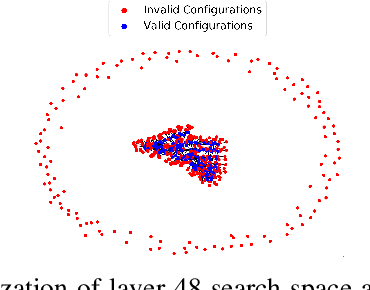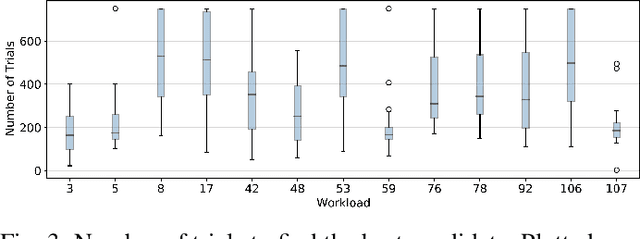Dennis Rieber
HW-Aware Initialization of DNN Auto-Tuning to Improve Exploration Time and Robustness
May 31, 2022



Abstract:The process of optimizing the latency of DNN operators with ML models and hardware-in-the-loop, called auto-tuning, has established itself as a pervasive method for the deployment of neural networks. From a search space of loop-optimizations, the candidate providing the best performance has to be selected. Performance of individual configurations is evaluated through hardware measurements. The combinatorial explosion of possible configurations, together with the cost of hardware evaluation makes exhaustive explorations of the search space infeasible in practice. Machine Learning methods, like random forests or reinforcement learning are used to aid in the selection of candidates for hardware evaluation. For general purpose hardware like x86 and GPGPU architectures impressive performance gains can be achieved, compared to hand-optimized libraries like cuDNN. The method is also useful in the space of hardware accelerators with less wide-spread adoption, where a high-performance library is not always available. However, hardware accelerators are often less flexible with respect to their programming which leads to operator configurations not executable on the hardware target. This work evaluates how these invalid configurations affect the auto-tuning process and its underlying performance prediction model for the VTA hardware. From these results, a validity-driven initialization method for AutoTVM is developed, only requiring 41.6% of the necessary hardware measurements to find the best solution, while improving search robustness.
The Programming of Deep Learning Accelerators as a Constraint Satisfaction Problem
Apr 13, 2021



Abstract:The success of Deep Artificial Neural Networks (DNNs) in many domains created a rich body of research concerned with hardware accelerators for compute-intensive DNN operators. However, implementing such operators efficiently with complex instructions such as matrix multiply is a task not yet automated gracefully. Solving this task often requires complex program and memory layout transformations. First solutions to this problem have been proposed, such as TVM or ISAMIR, which work on a loop-level representation of operators and rewrite the program before an instruction embedding into the operator is performed. This top-down approach creates a tension between exploration range and search space complexity. In this work, we propose a new approach to this problem. We have created a bottom-up method that allows the direct generation of implementations based on an accelerator's instruction set. By formulating the embedding as a constraint satisfaction problem over the scalar dataflow, every possible embedding solution is contained in the search space. By adding additional constraints, a solver can produce the subset of preferable solutions. A detailed evaluation using the VTA hardware accelerator with the Baidu DeepBench inference benchmark suite shows that our approach can automatically generate code competitive to reference implementations, and furthermore that memory layout flexibilty can be beneficial for overall performance. While the reference implementation achieves very low hardware utilization due to its fixed embedding strategy, we achieve a geomean speedup of up to x2.49, while individual operators can improve as much as x238.
 Add to Chrome
Add to Chrome Add to Firefox
Add to Firefox Add to Edge
Add to Edge